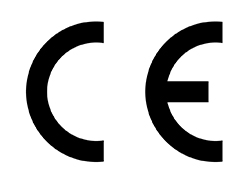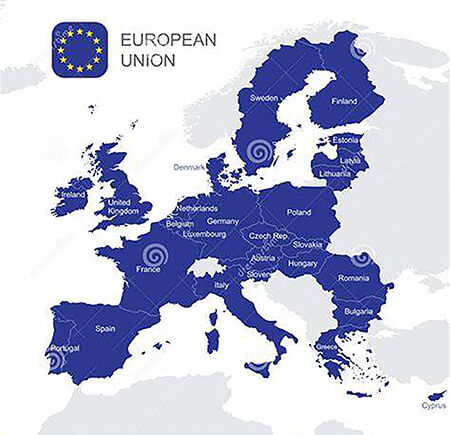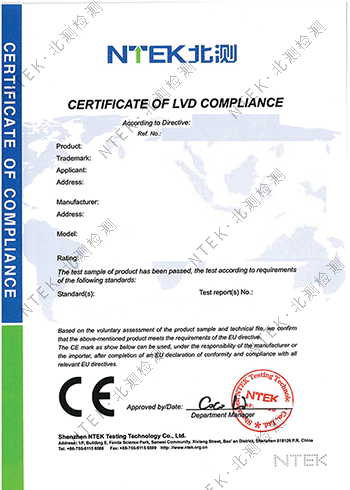CE certification profile
CE, abbreviated from French "Communate Europpene", is the meaning of the European Community, referred to as the European Union. The CE mark is mandatory in the EU market. Regardless of whether the products are produced by companies within the European Union or produced by other countries, if they want to circulate freely on the EU market, they must be affixed with the CE mark to indicate that the products comply with the EU's The New Approach to Technical Coordination and Standardization. technical harmonization and standardization).

Those without the CE mark cannot be sold on the market. Products that have been affixed with the CE mark and entered the market and found that they do not meet safety requirements shall be ordered to withdraw from the market. Those who continue to violate the relevant CE mark provisions of the directive will be restricted or prohibited from entering the EU market or Forced to exit the market.
CE certification basic information
Whether mandatory: mandatory + self-declaration
Certificate validity period: no validity period
Factory inspection requirements: no requirements
Certificate holder requirements: no requirements
Technical information: AC 230V, 50Hz / 60Hz, European standard plug CEE 7/7 & 7/16 or national standards
Applicable area
CE certification is available in 32 special economic zones in Europe, including: EU 28, EFTA Europe 3/4, Turkey. Products with CE marking can be freely distributed in the European Economic Area (EEA).
Specific EU 28 countries list: Belgium, Bulgaria, Czech Republic, Denmark, Germany, Estonia, Ireland, Greece, Spain, France, Croatia, Italy, Cyprus, Latvia, Lithuania, Luxembourg, Hungary, Malta, Netherlands, Austria, Poland , Portugal, Romania, Slovenia, Slovakia, Finland, Sweden, United Kingdom.

Note 1: EFTA includes four member states of Switzerland (Iceland, Norway, Switzerland and Liechtenstein), but CE marking is not mandatory in Switzerland;
Note 2: Because of the colonial era, CE certification is widely used and widely recognized worldwide. Some countries in Africa, Southeast Asia, and Central Asia may also receive CE certification.
Note 3: As of November 2019, Brexit is ongoing, and the follow-up results are yet to be determined.
Applicable product range
In order to understand the product range of CE, you must understand the NLF regulations of CE certification. NLF stipulates that products within its scope need to be CE certified. The EU's new legislative framework NLF currently has 22 directives, which are the following:
1. Toy Safety-Directive 2009/48 / EU
2. Mobile Pressure Equipment-Directive 2010/35 / EU
3. Restriction of dangerous substances in electrical and electronic equipment-Directive 2011/65 / EU
4. Building Products-Regulation No. 305/2011 (EU)
5.Pyrotechnic products-Directive 2013/29 / EU
6. Recreational boats and personal water boats-Directive 2013/53 / EU
7. Civil Explosives-Directive 2014/28 / EU
8.Simple pressure vessels-Directive 2014/29 / EU
9.Electromagnetic compatibility-Directive 2014/30 / EU
10.Non-automatic weighing instruments-Directive 2014/31 / EU
11.Measurement Instruments-Directive 2014/32 / EU
12.Lifts-Directive 2014/33 / EU
13. Equipment and protection systems for potentially explosive environments-Directive 2014/34 / EU
14.Radio Equipment-Directive 2014/53 / EU
15.Low voltage-Directive 2014/35 / EU
16.Pressure Equipment-Directive 2014/68 / EU
17.Ocean Equipment-Directive 2014/90 / EU
18. Ropeway installation-Regulation (EU) 2016/424
19.Personal protective equipment-Regulation No. 2016/425
20. Gas Appliances-Regulations (EU) 2016/426
21.Medical Devices-Regulation No. 2017/745
22. In vitro diagnostic medical equipment, Regulation (EU) 2017/746
Note: NLF refers to the EU ’s new legislative framework. The full name “New Legislative Framework” is a European Union ’s regulation to strengthen the market regulatory framework and recognition system for products. In addition to the unified definition of the concept, specific provisions have been made on national accreditation bodies and accreditation systems, the European market regulatory framework, product market access control, general rules for the use of logos, and European Community funding.
After familiarizing yourself with the regulatory framework, you can classify the corresponding products. The CE certification scope is very broad. Generally speaking, most products exported to the EU require CE certification. CE certification is mandatory for electronic products and toys exported to Europe, such as:
Power supply: communication power, charger, display power, LCD power, UPS, etc .;
Lamps and lanterns: chandeliers, track lights, garden lights, portable lights, down lights, light strings, table lights, grille lights, aquarium lights, street lights, energy-saving lamps, T8 lamps, etc .;
Household appliances: fans, electric kettles, stereos, televisions, mice, vacuum cleaners, etc .;
Electronics: earplugs, routers, mobile phone batteries, laser pointers, vibrators, etc .;
Communication products: telephones, wired and wireless main and auxiliary machines, fax machines, answering machines, modems, data interface cards and other communications products.
Wireless products: Bluetooth BT products, wireless keyboards, wireless mice, wireless readers, wireless transceivers, wireless microphones, remote controls, wireless network devices, wireless image transmission systems and other low-power wireless products;
Wireless communication: 2G mobile phones, 3G mobile phones, 3.5G mobile phones, DECT mobile phones (1.8G, 1.9G band), etc .;
Machinery: Gasoline engine, electric welding machine, CNC drilling machine, tool grinder, lawn mower, washing equipment, bulldozer, elevator, puncher, dishwasher, water treatment equipment, gasoline welding machine, printing machinery, woodworking machinery, rotary digging Drilling machines, lawnmowers, snowplows, excavators, printing machines, printers, cutting machines, rollers, trowels, brush cutters, hair straighteners, food machinery, lawn machines, etc .;
Medical equipment and toys.
Common electronic and electrical products are:
Low voltage directives: home appliances, IT / AV products, lighting products, etc.
Electromagnetic compatibility directives: home appliances, IT / AV products, lighting products, etc.
Machinery Directive: All related products
Radio frequency and communication terminal equipment instructions: wireless or communication terminal products
Application process
1. The applicant company fills in the application form, provides information, application form, product instruction manual and technical documents.
2. The agency evaluates CE certification inspection standards and CE certification inspection items and quotes.
3. Apply for company confirmation project and send samples.
5. The laboratory conducts product testing arrangements and reviews and evaluates the completeness of technical documents.
6. After the product test meets the requirements, provide a product test report or technical construction file to the applicant company, and issue a CE certificate after the test is passed.
7. The applicant company signs the CE guarantee self-declaration and attaches the CE mark on the product.
Application materials
1. The name and address of the manufacturer (EU authorized representative (EU authorized agent)), product name, model, etc .;
2. Product instruction manual;
3. Safety design documents (including key structural drawings, that is, design drawings that can reflect the climbing distance, clearance, number of insulation layers and thickness);
4. Product technical conditions (or enterprise standards), establish technical data;
5. Product electrical schematic diagram, block diagram and circuit diagram, etc .;
6. List of key components or raw materials (please choose products with European certification mark);
7. Testing Report;
8. Relevant certificates issued by the EU authorized certification body NB (for modes other than Mode A);
9. Registration certificate of the product within the EU (for some products such as Class I medical devices, general IVD in vitro diagnostic medical devices);
10. CE Declaration of Conformity (DOC);
Certificate information
The significance of CE certification
1. Necessity of applying for CE certification, products must be exported to Europe.
CE certification is a passport for products to enter the European Union and European Free Trade Area countries.
CE certification means that the product has met the safety requirements stipulated by the EU directive;
CE certification is a kind of enterprise commitment to consumers, which increases the level of consumer trust in products; products with the CE mark will reduce the risk of sales in the European market.
2. Benefits of applying for CE certification
The EU's laws, regulations and harmonized standards are not only large in number, but also very complex in content, so it is a wise move to save time and effort and reduce risks by obtaining the assistance of a designated EU agency;
Obtaining the CE certification by a European Union designated agency can maximize the trust of consumers and market surveillance agencies;
It can effectively prevent the emergence of irresponsible allegations; it will become technical evidence with legal effect.
 Hot Line
400-800-6106
Hot Line
400-800-6106


